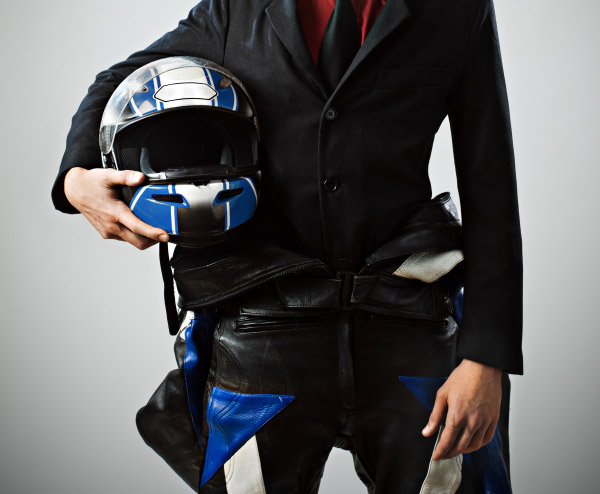 Global – Riders recognise that personal protective equipment may help to reduce injuries and death.
Global – Riders recognise that personal protective equipment may help to reduce injuries and death.
However, there is some confusion with regards to the standards for protective clothing.
The European Standards for protective clothing set minimum levels for various characteristics that should ensure that all clothing which claims to conform to the standards will provide a reasonable level of protection.
Clothing, gloves and boots which are subjected to testing and carry an independent and recognisable mark of reliability are a less “risky” purchase than unmarked clothing.
Motorcycle clothing can be divided into three groups:
- Non-protective. Outer clothing which constitute a barrier to the elements: heat, cold, wind and rain.
- Non-protective supplied with CE impact protectors. A non-protective outer garment, as above, fitted with for example accredited shoulder, elbow, knee and back protectors bearing CE marking.
- Protective. Jackets, trousers, one-piece or two-piece suits, boots and gloves which are claimed by the manufacturer to be protective. Tested according to the European Standard and bearing CE marking. Garments must be fitted with CE marked protectors.
Where CE marked protectors are fitted to a non-protective garment (for example a textile jacket, or leather jacket, trousers and suits), this is misinforming consumers, because it claims that the whole garment is approved, but it is not.
Some garments feature a “CE” label which is sewn to the lining, but this refers only to the status of the fitted protectors.
Furthermore, CE certification is obtained by each individual manufacturer using a wide variety of “independent testers.” So even if the European standards are solid, the actual application of those standards to gear is impossible to verify with 100% accuracy.
MC tests back protectors pdf 156kb
Evaluation of Ballistic Materials for Back Protection Under Low Velocity Impacts pdf 1.6mb
However, by law all CE marked PPE must be supplied with detailed, printed information on selection, care and maintenance of the product.
Protective motorcycle clothing and impact protectors must be supplied to the consumer with such information and it must describe, for example: how the product was tested, the test data generated, how to remove and reinstall protectors (as may be necessary when cleaning the garment) and the anticipated service life or how to recognise when the PPE requires replacement.
According to a BMF article published in 2004
“Some garment suppliers have been fitting their products with protectors discovered to be fraudulently CE marked. In 2002, one UK-based distributor was caught out when Trading Standards purchased one of its garments and arranged for the fitted protectors to be independently tested. The protectors failed to meet the requirements of EN 1621-1 and the distributor’s stock of garments was reportedly impounded until the non-conforming protectors were replaced with the genuine item”.
For an excellent description of the issues surrounding personal protective equipment, PVA Technical File Services Ltd has set out in detail a buyer’s guide, the path to the standards and the standards explained on the following site: Click Here
In the US there are no official government standards setting organizations per se; the U.S. is one of the only countries in the world where the government is not in the business of setting standards. The standards organizations in the U.S. are all private sector based and the adoption and use of standards is market driven.
In Europe, enforcement of the CE standard measures is reliant on effective national market surveillance and inspection and resources for such activities have been cut in many Member States in recent years. More than ever, consumers will need to know that CE Marking means Caveat Emptor (‘let the buyer beware’)”. eSUM – Protective Equipment for Riders pdf 1.5mb
Finally, in terms of mitigating factors for injuries, the On The Spot (OTS) study carried out in Great Britain on behalf of the Department for Transport, (Feb. 2008) reports that protective clothing including helmets had no effect on the severity of the injuries incurred by riders.
The table below shows a range of countermeasures for motorcyclists (behaviour). There were no significant effects of countermeasure on the accident severity rating.
The effect of countermeasures on ISI
| Countermeasure | Mitigating factor | Relative effect on severity (difference from baseline) | Total Frequency | |
| Present | Not present | |||
|
Road user behaviour |
Helmet worn | No effect | 166 | 14 |
| Reflective clothing worn | No effect | 174 | 28 | |
| Dedicated motorcycle clothing worn | No effect | 83 | 119 | |
Source On The Spot study, DfT 2008, page 52 Table 4.39; (ISI: Injury severity index)
An article from “The Independent” in 2004, argues that “The power of the modern machine is awesome, a different proposition from the bikes of the 1970s. The Yamaha YZF-R1, launched this year, has 180 brake horse power and was described by one motoring reviewer as “faster than a Ferrari for the price of a Fiesta”, the equivalent of a stripped-down Vauxhall Vectra with two Formula One engines”.
And this according to the article’s writer Nicholas Pyke, is much of the problem. He writes “The technology has changed so radically since the Jeremy Irons wannabes last donned leathers, that they barely know how to work the controls”.
As Ian Mutch (President MAG UK) puts it: “When they learned to ride, bikes were powered by the equivalent of a hairdryer.
Pyke argues that “Even modern braking systems take careful handling. Inexperienced riders, frightened at their new-found speed, are tempted to squeeze hard approaching bends, and they can easily find themselves flying over the handlebars”.
While the emphasis in Europe at least is on safety and encourages the use protective equipment to save lives, it is the very same industry that sells the lifestyle of road racing.
According to Pyke “Britons are spending £10,000 and more on machines capable of 150mph. When the weekend comes round, they dress up in expensive, one-piece racing suits and speed from the suburbs of London and Manchester for the roads of rural Britain, with frequently disastrous consequences”.
Quoting a representative of MAG UK the article continues:
“To ride a modern sports bike after only 10 to 20 hours of instruction seems to be a recipe for disaster. It seems that a majority of sports-bike riders use leather suits, EU-approved body armour etc. The eager adoption of this race-track equipment betrays an attitude that the road is simply an extension of the race track.
Too much reliance is placed on ‘protective clothing’ which works well on a race-track, where riders can slide without encountering obstacles, unlike the public road. The problem is a cultural one rather than one resulting simply from the potential of modern machines.”
Trevor Baird


Thanks Paul – we hear you are or were currently involved in “lobbying” with the current changes on testing methods on PPE motorcycle clothing…….
The “CE – Conformité Européenne or caveat emptor?” question was originally coined by me. It sought to establish the distinction between motorcycle clothing which has been tested and certified to the European Standards and that which has not. The fitness for purpose of one is an established quantity. The other may be equally as good, or it might not; hence “caveat emptor” or “the other ‘c.e..” as I also often express it.
I hope this helps
In the article we provided a link to a website that has a very detailed explanation about CE markings in relation to protection:
http://www.pva-ppe.org.uk/information-resources/the-european-mc-clothing-standards/
where they state “by law all CE marked PPE must be supplied with detailed, printed information on selection, care and maintenance of the product. Protective motorcycle clothing and impact protectors must be supplied to the consumer with such information and it must describe, for example: how the product was tested, the test data generated, how to remove and reinstall protectors (as may be necessary when cleaning the garment) and the anticipated service life or how to recognise when the PPE requires replacement.
Contact details for the European Notified Body responsible for the testing and certification will also be provided, from which you will be able to contact them to determine the authenticity or otherwise of the manufacturer’s claims.
If you are unsure how to go about this, your local Trading Standards Department may be prepared to assist”.
Hope that helps.
Good Morning
I was involved in a slow speed RTA which caused me to fall
to my left. My left elbow took the brunt of the impact which resulted
in nerve and soft tissue damage. At the time I was wearing a Hein
Gericke GTX Journey jacket which had those pads that were supposed to mould to my arm and harden on impact. Unfortunately, the pads did not not protect my elbow as they had moved away from them so it came into direct contact with the road.
The question that I have is about my rights as a motorcycle consumer and the jackets inability to do what I bought it for, to protect me. Does the CE standard come into play or is it just a guide?
Nizan
Press release from the EU Commission on CE markings
http://europa.eu/rapid/press-release_IP-10-733_en.htm?locale=en
Industry and Entrepreneurship Commissioner, Vice-President Antonio Tajani said: “We need to boost the visibility of and public trust in the CE marking. Our campaign aims to promote a better understanding of the meaning behind the marking and the purpose of its use. However, this confidence is also dependent on the reliability of the system on which the CE mark is based. Thus it will boost consumer’s confidence and benefit producers and distributors.”
The procedures, measures and sanctions applying to counterfeiting/abuse of the CE marking are laid down in the respective Member State’s national administrative and penal law. Depending on the seriousness of the offence, economic operators may be liable to a fine and in some circumstances, imprisonment. However, if the product is not regarded as an imminent safety risk, the manufacturer may be given a second opportunity to ensure that the product is in conformity with the applicable legislation, before being obliged to take the product off the market.
Caveat Emptor is a legal term meaning “let the buyer beware”. The referral is to European products that carry CE markings- not the eSum document. However the eSum document refers to European products and on page 8 mentions (E)CE markings. The fact is that the eSum document should mention CE markings throughout, but doesn’t.
No, I’m not suggesting that CE markings have lost their meaning. CE markings are a standard – that some manufacturers do not comply to – hence – Caveat Emptor “let the buyer beware”
Trevor
Trevor, what is meant by the comment:- “More than ever, consumers will need to know that CE Marking means Caveat Emptor (‘let the buyer beware’)”. eSUM – Protective Equipment for Riders pdf 1.5mb”.
There is nothing in the eSUM document that it implies CE means Caveat Emptor. Should this reference be removed?
Are you suggesting that the system of marking motorcycle protective clothing is so flawed that CE Marking has lost its meaning and that riders should be cautious when purchasing CE marked product to ensure that it actually complies with CE Standards?
Safe riding,